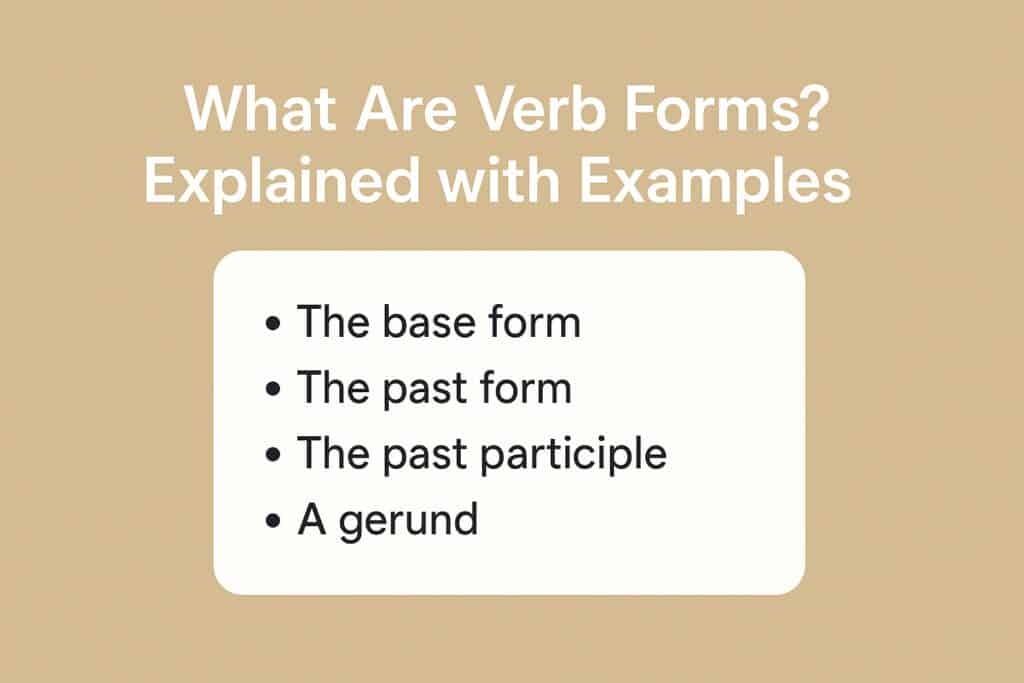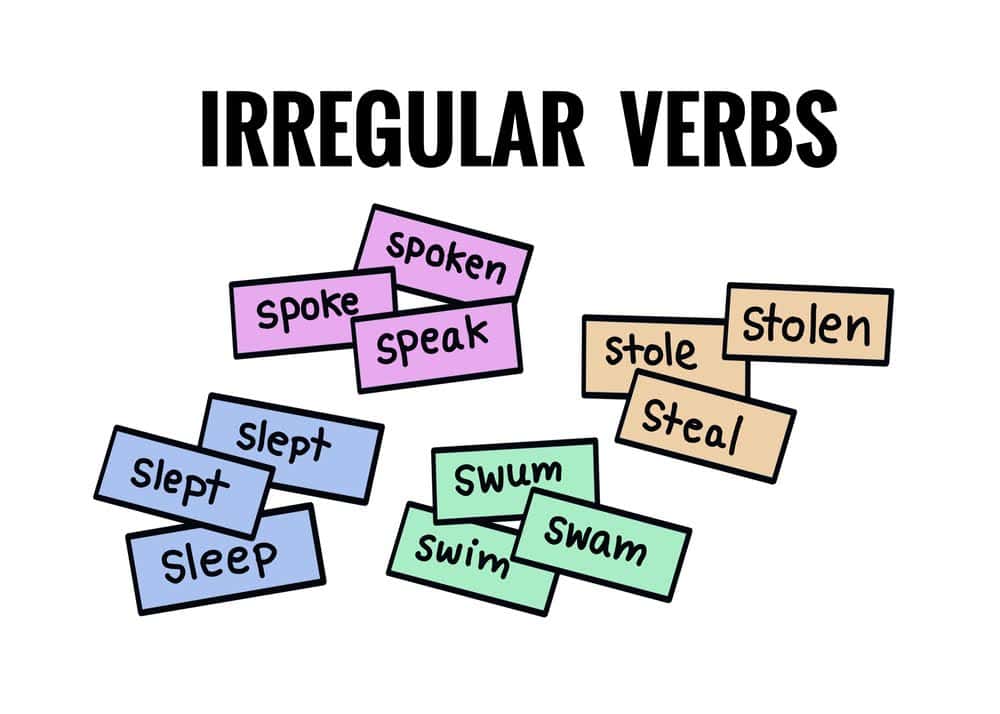There are five main verb forms in English, and no, this isn’t just another grammar fact to forget later.
The base form, third-person singular form, past simple, past participle, and present participle are actually what keep your sentences from sounding like glitchy text messages.
In this article, I’ll discuss what are verb forms with their examples, how these forms behave in different tenses, how they team up with auxiliary verbs, and so much more!
Key Takeaways
- Verb forms change based on tense (present, past, future), aspect (simple, perfect, continuous), and voice (active vs. passive).
- Auxiliary verbs (like be, do, and have) build different verb structures, including questions and negatives.
- Modal verbs (can, should, might, must, etc.) always pair with base verb forms to express ability, advice, possibility, or necessity.
What Are Verb Forms?

A verb form is simply the shape a verb takes to fit its job in a sentence.
English verbs change their versions depending on when something happens (past, present, future), whether the action is ongoing or completed, and sometimes just because grammar says so.
Now, how many verb forms are there in English?


Never Worry About AI Detecting Your Texts Again. Undetectable AI Can Help You:
- Make your AI assisted writing appear human-like.
- Bypass all major AI detection tools with just one click.
- Use AI safely and confidently in school and work.
Fortunately, the language doesn’t overwhelm us with hundreds of forms.
Most verbs cycle through just a handful.
Main Categories: Base, Past, Participle, Gerund
Here are the four main categories of verbs:
- The base form is the raw, dictionary version of the verb with no endings or tense markers, used for simple present tense. (Examples: run, eat, think.)
- The past form is used when an action has already happened. Regular verbs just add “-ed” (walk → walked) to form the past form.
- The past participle is often confused with the past form, but it’s used with “have/has/had” or in passive voice. (Examples: have eaten, had gone, was stolen.)
- A gerund is a verb acting like a noun that always ends in “-ing.” (Examples: Running is fun, I enjoy swimming, she’s good at reading.)
The Five Primary Verb Forms
According to Cambridge Dictionary, there are five primary verb forms you need to know: the base form, past simple, past participle, present participle, and the third person singular present.
1. Base Form (Infinitive Without “to”)
This is the verb in its most basic state, the one you’d look up in a dictionary. It is also called the bare infinitive because it’s the infinitive without the “to.”
You can consider it the default setting of a verb that gets changed with different tenses and usages.
It shows up in present tense sentences with subjects like “I,” “you,” “we,” and “they,” as in “I write stories” or “They run every day.” You’ll also hear it after modal verbs: “She can sing,” “They should study.”
2. Past Simple
The past simple form of the verb is used when you’re talking about something that already happened.
Regular verbs have predictable past simple forms, just add “-ed” and you’re done (walk → walked, jump → jumped).
Irregular verbs, however, don’t play by the rules (go → went, write → wrote), so you’ll have to learn those individually.
3. Past Participle
The past participle looks identical to the past simple for regular verbs (walked, jumped), but it has a completely different job.
It’s used with auxiliary verbs to form perfect tenses or passive voice.
For instance, “I have written three books,” or “The window was broken during the storm.”
4. Present Participle (-ing)
The present participle is the “-ing” form of a verb and shows ongoing or continuous action. You see it in progressive tenses like “She is cooking dinner,” or “They were watching a movie.”
This verb form can also be used to join multiple actions. For example, “She walked down the street, singing softly.”
5. Third Person Singular Present
Finally, English throws in one more change when you’re speaking in the present tense about “he,” “she,” or “it.” That’s the third person singular present form.
Most verbs just need an “-s” to be added in this form, like “She writes novels,” or “He eats lunch early.”
Verbs ending in “-ch, -sh, -s, -x, or -o require an “-es”, as in, “He watches TV,” or “She goes out often.”
Verb Form Examples
To see how all the different verb forms are used in sentences, take the example “write.”
The base form is “write,” the past simple is “wrote,” the past participle is “written,” the present participle is “writing,” and the third person singular present is “writes.”
Now, put them into sentences, and you’ll recognize the differences:
- Base form: “I write every day,”
- Past simple: “Yesterday I wrote a letter,”
- Past participle: “I have written ten pages,”
- Present participle: “I am writing one now,”
- Third-person singular form: “She writes for a living.”
Undetectable AI’s Ask AI is a great tool for learning to recognize these patterns.

Practice the verb forms using different action words and get instant, personalized feedback until switching between verb forms comes naturally to you.
Regular vs Irregular Verb Forms
All English verbs fall into two camps. Some follow predictable rules (regular), while others do their own thing (irregular).
What Makes a Verb Regular?
Regular verbs follow simple rules of English. To make them past tense or form their past participle, you just add “-ed” to the base form. That’s it.
- Walk → walked
- Jump → jumped
- Talk → talked.
It’s neat, predictable, and exactly what you’d expect.
Irregular Patterns: No Clear Rule
Irregular verbs, on the other hand, laugh at that rule. They change in unique, sometimes baffling ways such that there’s no consistent pattern you can rely on.
For example:
- Go → went → gone
- Eat → ate → eaten
- Sing → sang → sung
List of Common Irregular Verbs

You simply have to memorize common irregular verbs. Many English learners often trip over irregular verbs because the language gives them no warning before breaking its own rules.
Here’s a quick list of common irregular verbs you’ll run into often:
- Go → went → gone
- See → saw → seen
- Take → took → taken
- Write → wrote → written
- Drink → drank → drunk
- Begin → began → begun
- Eat → ate → eaten
- Speak → spoke → spoken
- Cut → cut → cut
- Put → put → put
You can find the full list of irregular verbs here.
Verb Forms in Different Tenses

Now that you’re familiar with the basic forms of verbs, let’s understand how they are used in different tenses.
Present Tense and Verb Forms
In the present tense, we often use the base form of the verb. However, the base form gets converted into third person singular if you’re referring to, well, a third person, i.e., he/she/it.
For continuous actions that are happening in the present moment, we use the present continuous form.
The verb can be regular or irregular, it’ll stay in its base form.
Past Tense and Verb Changes
The past tense calls for the past form of the verb. For regular verbs, you just need to add -ed to the base form.
Irregular verbs, though, have their own past tense forms that don’t follow any particular pattern.
For continuous actions happening right now, we use the present continuous form with the following structure:
Subject + was/were + present participle (Example: We were watching a movie.)
Future Forms: Will, Going To, Modals
The future tense doesn’t have a dedicated verb form like past or present. Instead, we build it using helper verbs. There are two ways to do it:
Will + base verb:
- Example: I will call you later. (Simple future)
Going to + base verb:
- Example: We are going to travel next week. (Planned future)
Modal verbs (like may, might, shall, should, can, could) also form future-like expressions. For example:
- She might join us tomorrow.
- You should prepare before the meeting.
Again, the verb that follows a modal is always in the base form.
Perfect and Continuous Forms
These tenses combine auxiliary verbs with past or present participles. Here’s how to use them:
- Present perfect: have/has + past participle
- Example: I have finished the report.
- Example: I have finished the report.
- Past perfect: had + past participle
- Example: They had left before I arrived.
- Example: They had left before I arrived.
- Future perfect: will have + past participle
- Example: She will have graduated by next year.
There’s another category of tenses that combine the perfect and the continuous forms. They are formed in the following ways:
- Present perfect continuous:
- I have been working all day.
- I have been working all day.
- Past perfect continuous:
- We had been waiting for hours.
- We had been waiting for hours.
- Future perfect continuous:
- She will have been studying for three years by then.
Auxiliary Verbs and Verb Forms
Auxiliary verbs, also known as helping verbs, don’t carry much meaning on their own, but they support the main verb to build tense and voice in a sentence.
Helping Verbs: Be, Do, Have
There are three main helpers you’ll run into, be, do, and have.
- Be pairs up with the -ing verb form (present participle). Am, is, are, was, were are all variations of the root word be.
- Do (and its variations, does and did) is used for emphasis, negatives, and questions. When do is in the sentence, the main verb stays in its base form.
- Have (also, has and had), is used to talk about anything that’s been done before now, so it makes sense that you use a past participle after it.
Verb Forms with Modals: Can, Should, Might
Modals like “can,” “should,” and “might” are also a type of auxiliary verb.
They always keep the same form no matter the subject, and they’re always followed by the base form of the main verb.
Negative and Interrogative Structures
Auxiliaries are absolutely necessary when forming negatives and questions.
You cannot make a sentence negative in English without a helping verb. “I not like pizza” is grammatically incorrect. The correct version of the same sentence is “I do not like pizza.”
Similarly, if you form a yes-or-no question, you need to bring in an auxiliary verb. You can’t just say “You like tea?” unless you’re being deliberately casual. Grammatically, the correct structure is “Do you like tea?”
Verb Forms in Passive Voice
The core aspect of every passive sentence is the formula: be + past participle. That’s it.
The auxiliary verb “be” does all the tense work, and the past participle form of the main verb just tags along.
Look at the following examples to understand it better:
- Present: The letters are delivered every morning.
- Past: The window was broken last night.
- Future: The package will be delivered tomorrow.
Verb Forms in Conditional Sentences
Conditional sentences are used to talk about possibilities or consequences of certain actions.
The 4 most commonly used types of conditionals are:
1. The zero conditional, where we talk about general truths, e.g., If you heat water to 100°C, it boils. In such sentences, both the if clause and the main clause use the base verb form.
2. The first conditional is used for real, possible situations in the future, e.g., If it rains, I will stay home. Here, the if clause uses present simple, while the result clause uses will + base verb.
3. The second conditional denotes imaginary scenarios, e.g., if I won the lottery, I would travel the world.
These sentences use the past simple in the if clause, even though we’re not talking about the past. The main clause uses would + base verb.
4. Finally, the third conditional is used to look back at past situations that didn’t happen, e.g., if she had studied, she would have passed. Here, the if clause uses past perfect (had + past participle), and the main clause uses would have + past participle.
The rules for conditional sentences are confusing for many learners, so whenever you use these, make sure to check your grammar usage through Undetectable’s free AI Grammar Checker.

Work smarter—analyze and improve your content with just one click below.
Final Thoughts
I hope this article helped clear up some of the fog around verb forms.
Heads up, reading about grammar feels great, quite productive, but actually using it correctly requires tons of practice.
Head over to Undetectable AI’s AI Chat to create yourself practice worksheets based on exactly what you want to work on, and get instant feedback when you make a mistake.
Or, try using a free Grammar Checker to see the progress you’ve made using verb forms.
Sign up at Undetectable AI today. Happy learning!
